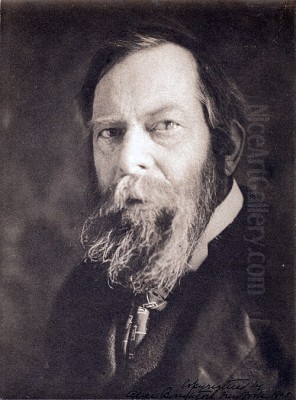
Albert Pinkham Ryder stands as one of American art's most intriguing and poetic figures. A painter whose life was as shrouded in mystery as his moonlit canvases, Ryder forged a unique path, distinct from the prevailing artistic currents of his time. His work, characterized by its deeply personal symbolism, rich, dark palettes, and an almost mystical approach to landscape and legend, has continued to fascinate and inspire generations. Born on March 19, 1847, in the whaling port of New Bedford, Massachusetts, and passing away on March 28, 1917, in Elmhurst, New York, Ryder left behind a relatively small but profoundly impactful body of work that marks him as a visionary precursor to modernism.
Early Life and Artistic Awakening
The maritime environment of New Bedford undoubtedly left an indelible mark on young Ryder. The tales of the sea, the ever-present ocean, and the ships that sailed into the unknown likely fueled his burgeoning imagination. His family, of old New England stock, moved to New York City around 1867-1868, a pivotal moment that placed Ryder at the heart of America's burgeoning art world. Though his formal art education was somewhat sporadic – he was initially rejected by the National Academy of Design but later studied there for a few years under William Edgar Marshall – Ryder was largely self-taught. This independence from academic convention allowed him to develop a highly idiosyncratic style.
Ryder's early works often depicted gentle pastoral scenes, reflecting the influence of the French Barbizon School, whose artists like Jean-Baptiste-Camille Corot and Jean-François Millet were popular in America. These painters emphasized mood, atmosphere, and a subdued palette, qualities that Ryder would absorb and transform. However, even in these earlier pieces, a distinctive sensibility began to emerge, a tendency towards simplification of form and an emphasis on the emotional resonance of a scene rather than its literal depiction. He was less interested in capturing the fleeting effects of light in the Impressionistic manner, which was gaining traction, and more focused on the enduring, often melancholic, spirit of his subjects.
The Emergence of a Singular Vision: Tonalism and Symbolism
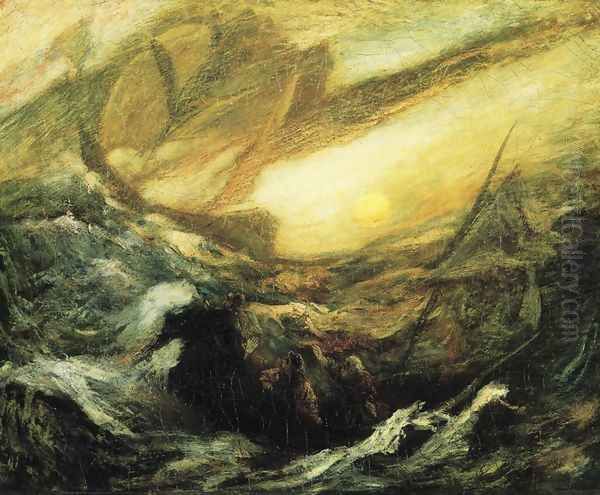
As Ryder matured, his art evolved into a deeply personal form of expression that is often associated with Tonalism, yet transcends easy categorization. Tonalism, an American artistic style that emerged in the 1880s, favored muted colors, soft edges, and evocative atmospheres, aiming to convey mood and spiritual feeling. Ryder was a master of this approach, using a limited palette of rich, dark hues – deep blues, greens, browns, and golden yellows – often applied in thick layers, to create canvases that seemed to glow from within. His paintings are not merely representations of the external world but are windows into an inner landscape of dreams, memories, and emotions.
Beyond Tonalism, Ryder's work is profoundly Symbolist. He drew inspiration from a wide array of sources, including the Bible, Shakespearean tragedies, classical mythology, Romantic poetry (like that of Edgar Allan Poe), and Wagnerian operas. These literary and mythological themes were not simply illustrated but were reinterpreted through Ryder's unique visionary lens. He sought to capture the essential, often tragic or mysterious, core of these narratives, imbuing them with a universal, timeless quality. His figures are often simplified, almost archetypal, existing in dreamlike settings where the boundaries between reality and imagination blur.
The sea became a recurring and powerful motif in Ryder's art. Unlike many of his contemporaries who depicted the ocean with documentary precision or Impressionistic vibrancy, Ryder's seascapes are primal and elemental. They speak of solitude, the immense power of nature, and the eternal human struggle against forces beyond our control. These marine paintings, often bathed in moonlight, are among his most iconic and emotionally charged works.
Masterworks: Journeys into the Mystical
Ryder's oeuvre, though not extensive (estimated at fewer than 200 paintings), contains several masterpieces that encapsulate his unique artistic vision. Each work was the result of a long, painstaking process, with the artist often laboring over a single canvas for years, applying layer upon layer of paint, varnish, and unconventional materials.
_The Flying Dutchman_ (c. 1887): Inspired by the legend of the cursed ghost ship doomed to sail the seas forever, this painting is a quintessential Ryder. A spectral vessel, illuminated by an eerie, supernatural light, ploughs through a turbulent, dark sea under a stormy sky. The work evokes a profound sense of dread, mystery, and the sublime power of the ocean. The simplified forms and dramatic chiaroscuro contribute to its haunting, dreamlike quality.
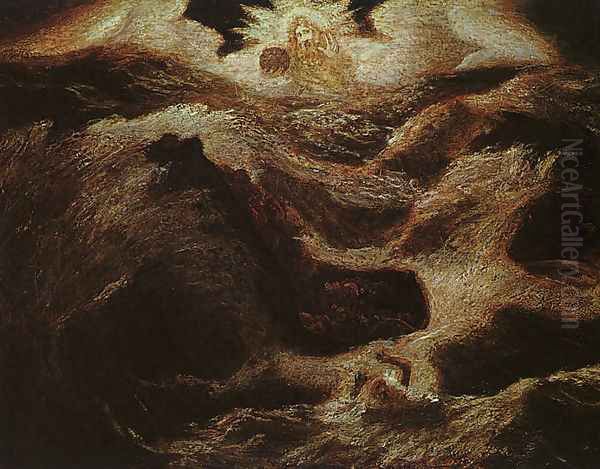
_Jonah_ (c. 1885-1890s): This biblical scene is transformed into a maelstrom of divine power and human frailty. Jonah is depicted adrift in a chaotic sea, with a monstrous whale looming and God appearing in the tumultuous clouds. Ryder captures the terror and awe of the moment, not through detailed realism, but through expressive forms, swirling paint, and a dramatic interplay of light and shadow. The work speaks to themes of faith, retribution, and the overwhelming force of nature and the divine.
_Siegfried and the Rhine Maidens_ (1888-1891): Drawing from Wagner's opera cycle "Der Ring des Nibelungen," this painting is a luminous and poetic interpretation of the mythological scene. Siegfried, the hero, is shown on horseback encountering the ethereal Rhine maidens in a moonlit, enchanted forest. The figures are almost absorbed into the landscape, rendered with a soft, glowing quality that enhances the otherworldly atmosphere. The painting is a testament to Ryder's ability to translate complex narratives into deeply felt visual poetry.
_The Race Track (Death on a Pale Horse)_ (c. 1896-1908): This stark and unsettling painting is one of Ryder's most enigmatic. A skeletal figure of Death, scythe in hand, rides a pale horse around a desolate, circular track under a somber sky. The work is believed to have been inspired by the suicide of a waiter who had bet his life savings on a horse race. Beyond this specific anecdote, the painting serves as a powerful memento mori, a universal allegory of the futility of worldly pursuits and the inevitability of death. Its minimalist composition and chilling symbolism make it profoundly impactful.
_Moonlight Marine_ (various versions, e.g., c. 1870-1890s): Ryder painted numerous "Moonlight Marines," each a variation on his favorite theme of the sea under the moon. These works, such as Moonlit Cove or Moonlight Bay, are characterized by their simplicity of form, with a few key elements – a boat, the moon, clouds, and water – rendered in rich, dark tones. The moonlight, often a soft, diffused glow, creates an atmosphere of profound stillness, mystery, and introspection. These paintings are less about specific locations and more about evoking a universal emotional response to the beauty and solitude of the night sea.
_Toilers of the Sea_ (c. 1880-1884): Inspired by Victor Hugo's novel, this painting depicts a small boat battling a vast, dark sea under a luminous, cloud-swept sky. It’s a powerful image of human endurance against the overwhelming forces of nature, a theme that resonated deeply with Ryder. The lone figure in the boat becomes a symbol of resilience and the solitary human condition.
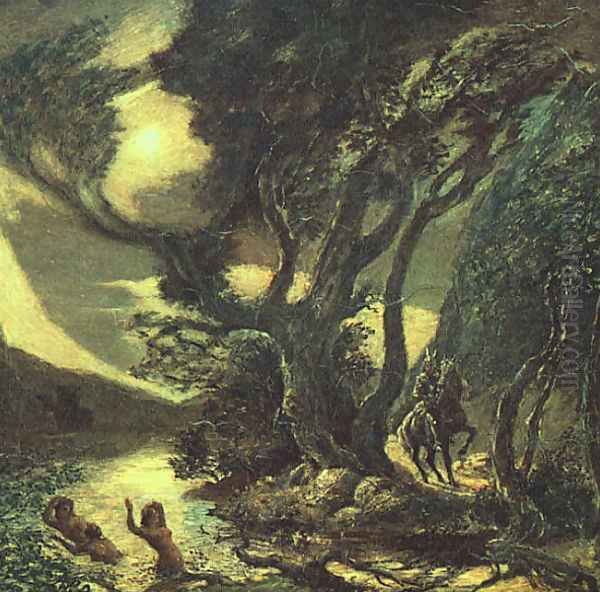
_Macbeth and the Witches_ (c. 1890-1908): Shakespeare was a significant source of inspiration for Ryder. This painting captures the eerie encounter on the heath, with the three witches appearing as spectral, almost elemental figures before Macbeth and Banquo. The landscape itself seems charged with supernatural energy, reflecting the dark prophecies and tragic destiny that await.
Unconventional Techniques and Material Challenges
Ryder's approach to the physical act of painting was as unconventional as his artistic vision. He was notorious for his experimental use of materials, often mixing paint with varnish, bitumen, wax, candle grease, and even alcohol. He would apply paint in thick layers, reworking canvases over many years, sometimes even painting over still-wet underlayers. While this laborious process contributed to the rich, jewel-like surfaces and deep luminosity of his works, it also led to severe conservation problems.
Many of Ryder's paintings began to crack, darken, and deteriorate even during his lifetime. The unstable combinations of materials and his layering techniques meant that his works were prone to wrinkling, alligatoring (a pattern of cracking resembling alligator skin), and significant changes in color and texture over time. This has presented immense challenges for conservators and means that many of his paintings today may look quite different from how they appeared when he considered them finished. Despite these material issues, the spiritual and poetic power of his art remains undiminished. His willingness to prioritize expressive effect over technical orthodoxy was characteristic of his singular focus.
The Reclusive Genius: A Life Apart
Albert Pinkham Ryder cultivated an image of a reclusive, almost hermit-like figure, dedicated entirely to his art. He lived in modest, often cluttered, rooms in New York City, surrounded by his paintings, books, and an accumulation of everyday detritus. Descriptions from contemporaries paint a picture of a man indifferent to material comforts, often unkempt in appearance, living a life of spartan simplicity. His apartment was famously chaotic, with food scraps, rubbish, and art supplies intermingled.
While he was certainly introverted and preferred solitude for his creative work, the image of a complete recluse might be an exaggeration. He maintained friendships with a small circle of artists, writers, and patrons, including the sculptor Olin Levi Warner and the painter J. Alden Weir. He would occasionally venture out for walks, often at night, finding inspiration in the moonlit city or the natural landscapes he encountered. He also corresponded with friends and occasionally traveled to visit them.
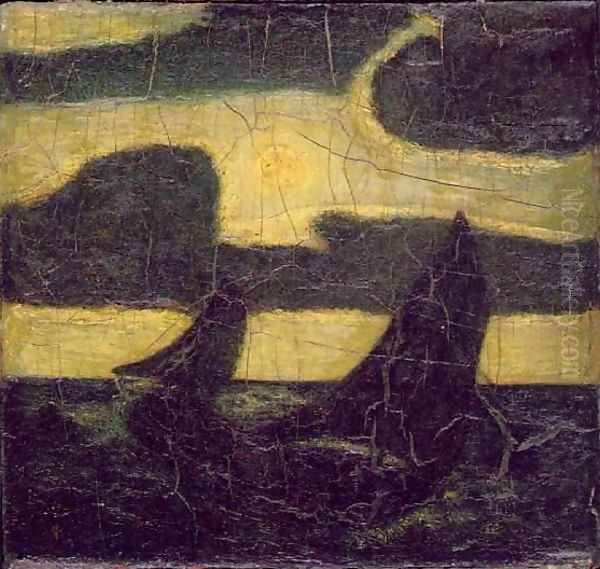
Ryder was known for his gentle, unassuming nature, yet he possessed an unwavering artistic integrity. He was slow to part with his paintings, not due to commercial shrewdness, but because he rarely considered them truly finished, always seeing potential for further refinement. This perfectionism, combined with his unconventional lifestyle, contributed to his mystique. His health was often poor, particularly in his later years, suffering from what was then termed "neurasthenia" and eventually succumbing to kidney disease. He spent his final years cared for by friends, Charles and Louise Fitzpatrick, in Elmhurst, Long Island.
Ryder and His Contemporaries: A Singular Path
In the landscape of late 19th and early 20th-century American art, Ryder stands apart. While contemporaries like Winslow Homer captured the raw power of nature with a vigorous realism, and artists like John Singer Sargent and William Merritt Chase embraced a more cosmopolitan, Impressionist-influenced bravura, Ryder delved into a more internal, spiritual realm.
He shared some affinities with other Tonalist painters such as George Inness, Dwight Tryon, and John Henry Twachtman (who also explored Impressionism). Like them, Ryder was interested in mood and atmosphere over precise depiction. However, Ryder's symbolism was often more overt and his forms more radically simplified than many of his Tonalist peers. James McNeill Whistler, another contemporary with Tonalist leanings, also sought musicality and harmony in his "Nocturnes," and there's a shared sensibility in their evocative use of limited palettes and atmospheric effects, though their personalities and approaches differed significantly.
Ryder's connection to the Barbizon School, brought to American attention by artists like William Morris Hunt, is evident in his early work's pastoralism and focus on mood. However, he quickly moved beyond these influences to forge his own path. He was less connected to the academic traditions upheld by figures like Thomas Eakins, whose focus was on unflinching realism and anatomical accuracy. Nor did his work align with the grand, often romanticized, landscapes of the Hudson River School painters like Albert Bierstadt, though a sense of nature's sublime power can be found in both.
One contemporary with whom Ryder is often compared, particularly in terms of their shared fate with forgeries, is Ralph Albert Blakelock. Both artists created highly individual, atmospheric landscapes, often moonlit, and both suffered from mental health issues and a lack of widespread understanding during parts of their careers. Tragically, the unique and hard-to-replicate styles of both Ryder and Blakelock, combined with their limited output and growing posthumous fame, led to them becoming two of the most forged artists in American history.
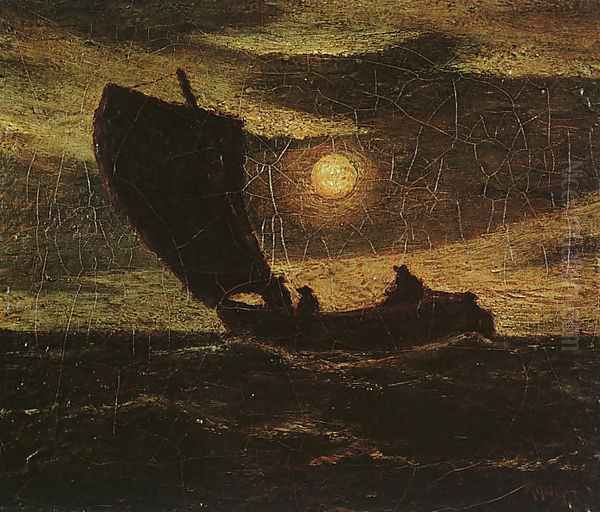
Ryder did have admirers among his fellow artists. Childe Hassam, a leading American Impressionist, knew Ryder in the mid-1890s and even included a Ryder painting in his personal collection, indicating a respect that transcended stylistic differences. There was also a reported mutual admiration between Ryder and Winslow Homer for their respective abilities to capture the elemental power of the sea, albeit through very different artistic languages.
The Armory Show and Growing Recognition
A significant moment in the public recognition of Ryder's work came with the 1913 Armory Show (officially The International Exhibition of Modern Art) in New York City. This landmark exhibition introduced American audiences to European avant-garde movements like Fauvism, Cubism, and Post-Impressionism, featuring works by artists such as Marcel Duchamp, Henri Matisse, and Pablo Picasso. Amidst these revolutionary European works, ten of Ryder's paintings were exhibited.
In this context, Ryder's art, with its emphasis on personal vision, emotional expression, and formal simplification, appeared remarkably modern and prescient. He was seen by some critics and younger artists as an American precursor to European modernism, an artist who had intuitively explored avenues of abstraction and subjective expression. The inclusion of his work in the Armory Show helped to solidify his reputation as a significant and original voice in American art, distinct from both academic tradition and straightforward Impressionism. His work resonated with a new generation of artists seeking to break free from representational constraints.
Enduring Legacy and Influence
Albert Pinkham Ryder's influence on subsequent generations of American artists has been profound and enduring, despite his reclusive nature and limited output. His commitment to an intensely personal vision, his willingness to experiment with form and material, and the sheer poetic power of his imagery marked him as a pivotal figure in the transition from 19th-century romanticism to 20th-century modernism.
Artists of the early American modernist movement, such as Marsden Hartley and Arthur Dove, openly admired Ryder. Hartley, in particular, saw Ryder as a spiritual forefather, an artist who, like himself, sought to express profound inner truths through art. Dove's near-abstract landscapes, with their organic forms and emphasis on the rhythms of nature, also share a spiritual kinship with Ryder's work. The British art critic Haldane Macfall, writing in 1920, astutely observed, "All that is vital in modern art was born in Ryder's work," a testament to his perceived modernity.
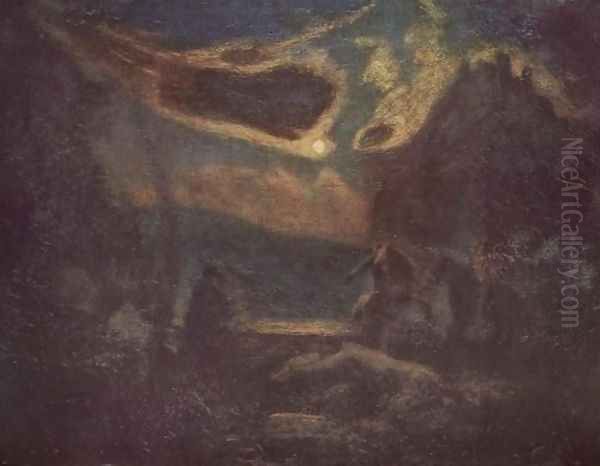
Even later, figures associated with Abstract Expressionism, such as Jackson Pollock, are said to have found inspiration in Ryder's all-over compositions, his textured surfaces, and the primal energy of his paintings. Pollock, known for his "drip" paintings, reportedly called Ryder "the only American master who interests me." The emphasis on the subconscious, the mythic, and the expressive gesture in Abstract Expressionism finds an antecedent in Ryder's deeply felt and intuitively created canvases.
Ryder's legacy is also one of independence. He was described as "entirely independent of contemporary and ancient art," forging a style that was uniquely his own. This fierce individualism served as an inspiration for artists seeking to find their own voice, unconstrained by prevailing trends or academic expectations. His work demonstrated that art could be a deeply personal and spiritual quest, a means of exploring the profound mysteries of existence.
The very fact that his works were so extensively forged speaks to their desirability and the unique qualities that others sought to emulate. Following his death, a memorial exhibition at the Metropolitan Museum of Art in New York in 1918 further cemented his status as a major American artist. His paintings continue to be prized for their haunting beauty, their emotional depth, and their timeless, enigmatic quality.
Conclusion: A Light in the Darkness
Albert Pinkham Ryder remains a singular figure in the annals of American art. He was a visionary who translated his inner world – rich with literary allusions, mythological echoes, and a profound connection to the sea – into paintings of extraordinary poetic intensity. His moonlit marines, his allegorical scenes, and his dramatic interpretations of legend and scripture are not merely pictures but are portals into a realm of dream and mystery.
Working in relative isolation, he developed a style that was both deeply personal and remarkably prescient, anticipating aspects of modernism with his emphasis on subjective experience and formal innovation. His unconventional techniques, while posing challenges for the preservation of his art, were part of his relentless pursuit of expressive power. Though his life was marked by reclusiveness and a disregard for worldly conventions, his art speaks with a universal voice, touching upon timeless themes of solitude, struggle, love, loss, and the sublime. Albert Pinkham Ryder's luminous, enigmatic canvases continue to shine, a testament to the enduring power of a truly original artistic spirit.